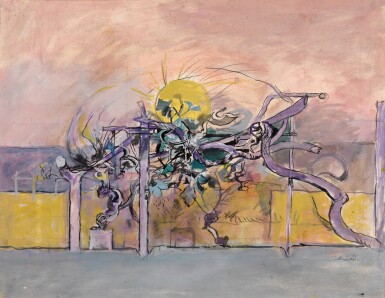Refining Taste: Works Selected by Danny Katz
Refining Taste: Works Selected by Danny Katz

GRAHAM SUTHERLAND, O.M. | VINE PERGOLA
Lot Closed
May 27, 02:16 PM GMT
Estimate
40,000 - 60,000 GBP
Lot Details
Description
GRAHAM SUTHERLAND, O.M.
1903-1980
VINE PERGOLA
signed Sutherland (lower right)
pencil, pen and ink, crayon, watercolour, gouache and wash on paper, squared for transfer
unframed (window): 48 by 62cm., 19 by 24¼in.
framed: 68.5 by 63.5cm., 27 by 25in.
Executed in 1948.
To view shipping calculator, please click here.
Giorgio Soavi, Milan, until 2009
Sotheby's Milan, 21 April 2009, lot 39
Private Collection, South Africa, until 2016
Graham Sutherland made his first trip to the South of France in 1947, a visit which would come to have a profound impact on his both his life and artistic aesthetic. Sutherland returned every summer to the Cote d’Azur where he mingled with glamorous expats such as Somerset Maugham and met both Picasso and Matisse. In 1955 he and his wife Kathleen bought a house in Menton, near the Italian border. The house had been designed in the 1930s by the modernist architect Eileen Gray and had stunning vistas over the Mediterranean and a lush garden planted with mandarin trees, mimosa and a tangled jungle of olive vines, a central motif in Sutherland’s later work.
Sutherland's palette had always been colourful, but now he swapped the cooler ochers of the primeval Pembrokeshire landscape for the saffron yellows and hot pinks of the Provencal countryside. The present work was painted in 1948 the same year as the magnificent oil Large Vine Pergola No.2 (British Art Council Collection). Both works reverberate with colour and dry heat and their construction owes much to the influence of Picasso and Cubism which afforded Sutherland’s pastoral Neo-romantic style a distinctly modernist geometry.
This sojourn to the warmth of the Cote d’Azur came in stark contrast to the austerity of post-war Britain with its cold winters, rationing and stagnant cultural scene. Sutherland’s naturally bohemian spirit was at home in France and his works from this period can be considered some of his most impassioned. With its depiction of gnarled vines illuminated by the large Mediterranean sun the present work is a sizzling example of Sutherland’s exquisite Provencal painting.
